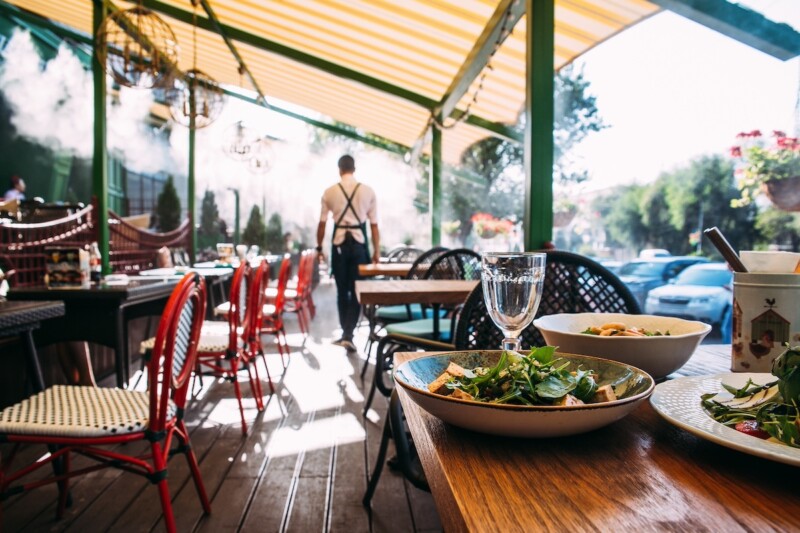A total overhaul of the 5,100-sq.-ft. servery on the ground floor of financial firm Wells Fargo’s headquarters in Charlotte, N.C., might seem like a foodservice designer’s dream. But there’s always a catch. In this case, the challenge was how to make the contract foodservice management provider’s precise vision for its corporate-dining plan play well within the building’s space constraints.
“The previous servery had a large footprint, but when you walked in, the space was so dark and disjointed that you couldn’t see all the stations at once,” recalls Reggie Daniel, FCSI, Design Director for the Atlanta/Charlotte-based foodservice consulting firm Camacho, which headed the servery renovation in conjunction with Wells Fargo and contract foodservice management provider Eurest Dining, a division of Compass Group. The old servery seemed dark and cramped because its low ceilings had been painted black, and a maze-like layout contributed to long waits for food during peak times.
Once the makeover was approved in December 2014, plans moved into high gear. Camacho received a set of preliminary drawings, including equipment specifications, previously designed by Wayne, Pa.-based Eurest and Wells Fargo; the plans were based on successful installations at Eurest’s corporate accounts across the country.
“It was a first to be handed completed drawings,” Daniel admits. “Our team sat down, analyzed the plans and asked lots of questions to make sure we understood what they wanted to achieve. We went over each piece of equipment to make sure it would do the job.”
Touring The Wells Fargo Servery
Wells Fargo’s new servery, opened in April 2015, is bright and airy, featuring natural wood veneer on counter cabinetry, wood elements on parts of the ceiling, white man-made stone countertops and “extremely bright lighting built into the glass breath guards to really highlight the food,” Daniel says.
The servery’s deceptively simple layout uses organic curves to encourage traffic to flow in a generally clockwise direction from entrance to exit. Matching curves on the floor and ceiling design subtly help signal customers where to move.
“Guests come into the servery past the Grab-and-Go station and tend to flow naturally to the left around the Salad island toward the Deli and Entree stations,” Daniel says.
The popular Grill and Ethnic stations anchor the back wall, while the Exhibition station is immediately to the right of the entrance. As guests head toward the cashiers and exit, they pass a Coffee island and Beverage areas, which include a freestanding beverage unit close to the POS for impulse buys and another against the wall for fountain drinks.
“The plan includes enough ‘milling’ space so people can double back and bounce around from station to station—an organized chaos, if you will,” Daniel says. “The Salad and Soup islands act as rocks in the proverbial stream, dividing the flow of guests and disrupting potential line formation.”
Each station is self-sufficient during serving times. “The Entree and Ethnic stations have hot and cold wells for serving, plus sufficient backup hot and cold storage to get through a meal period. The food is prepared in the support kitchen [located behind the Grill], which gives the stations more menu flexibility,” Daniel says.
For example, with many ethnic cuisines, a station would need to be equipped with highly specialized pieces of equipment. “Space constraints made it more practical for us to cook those food items in the production kitchen instead,” Daniel notes.
Guests still enjoy plenty of culinary action, however. “The Grill and Exhibition stations feature cooks preparing food to order on the grill, charbroiler and fryers. Employees at the Deli make sandwiches to order.”
The Salad bar serves dressings from a rotating refrigerated display based on a “lazy Susan” design. The unit, made by BSI, eliminates reach issues, saves countertop space and keeps the area neater.
During slow times, the cashier station can convert to self-checkout to save on labor costs. “Barcode stickers placed on food items during non-peak times allow guests to self-pay,” Daniel says.
‘Invisible’ Challenges
Three of the biggest challenges in designing the Wells Fargo servery are invisible to customers and most staff: refrigeration, ventilation and power supplies.
First up: refrigeration. Eurest asked that the servery’s stations be self-supplying throughout meal times, a request that boosted cold-storage demands considerably.
The solution was to opt for a remote refrigeration system. “Our concern with operating so many refrigerated units in the servery was noise, heat and, most of all, maintenance and repairs,” Daniel says. “Murphy’s Law says that if something’s going to break, it’ll be in the worst spot at the worst time.”
Construction crews dug trenches in the floor to hold the refrigerant piping as well as lines for water and power and drains where needed. “The massive amount of refrigeration meant there were 1-ft.-wide by 1-ft.-deep trenches everywhere,” Daniel recalls. “The floor was like a spider web.” Supply lines were laid and insulated, and trenches were refilled quickly then covered with a terrazzo finish.
The team specified an RDT remote refrigeration unit capable of powering the servery’s 23 pieces of cold equipment. The unit, generating nearly 170,000 Btu of refrigeration and measuring 92-in.L x 40-in.W x 80-in.H, was installed outside near the loading dock. Now, all of the heat and noise generated by the individual pieces of refrigeration equipment is dispelled collectively outside.
Ventilation posed its own challenges. The team had to rely on existing ductwork because expanding shafts in the high-rise building housing the servery would have been too expensive; additionally, the building’s relatively low ceilings could not provide the space required to enlarge the ductwork. But using two older hoods from the previous servery was out of the question.
“What they had before were short-cycle hoods—high-velocity units with an internal makeup-air supply system and high cfms that blasted air at the exhaust filters, causing effluent to roll out into the space,” Daniel says.
Specifying new hoods with variable-speed fans and lower cfm requirements not only allowed the design team to use current ductwork, they also could add a third hood to the servery.
“We moved two hoods forward on the cooklines at the Grill and Exhibition stations so cooks would face guests as they worked. The variable-speed fans reduce HVAC heating and cooling needs by exhausting air on a demand basis as the equipment is turned on,” Daniel says. The third hood is above the fryers at the Grill station.
“The variable-speed fans not only reduce HVAC heating and cooling needs by drawing out less air, they also do a better job capturing food odors, so the air quality is much better than it was before,” Daniel says.
To add more on-the-spot cooking action, planners also specified hoodless cooking equipment, such as a TurboChef accelerated oven for the Deli station and an Ovention oven for the Exhibition station.
Finally, to ensure long-term flexibility for each station, the design team placed MLO electrical panels—“main lug only” panels, also known as load centers—within each station’s counter rather than in the traditional spot on back walls. “This way, if the operator decides to add a new piece of equipment, they’ll be able to wire it directly to the [MLO] box at the station where it’ll be used,” Daniel says. “It’s far more cost effective in the long run.”
However, running electric lines through the cabinetry complicated the servery’s aesthetic design. “Eurest requested that trays, plates, bowls, to-go ware and snack chips for sale be stored in recessed shelves built into the front of the self-serve stations’ cabinetry for a neat, clean appearance,” Daniel says. “We spent a lot of time making sure the recesses were spaced just so in order to fit between the power-supply housings.”
Dishroom Tweak
The owners’ request to add a composting component to the servery’s operations led to dishroom equipment changes.
“We had been planning on installing a food-waste disposer that pulverizes food waste and sends it down the drain,” Daniel says. “But because of composting, we opted for a recirculating food-waste collection unit made by Salvajor.” The unit collects solid food waste so it can be disposed of in the trash while sending water-soluble waste down the drain, reducing overall waste bulk and weight.
Another dishroom addition was a flatware washer by Power Soak. The washing system eliminates the need to run flatware through a dishmachine twice, which was a common practice because utensils would nest and not get clean. “This unit cleans the flatware the first time and does a better job,” Daniel says.
SPECS
MENU/SEGMENT: Corporate dining
LOCATION: Charlotte, N.C.
FOODSERVICE OPERATOR: Eurest Dining/Compass Group, Wayne, Pa.
BUILDING POPULATION: 6,000
COVERS PER DAY: 1,500 meals
SERVERY SIZE: 5,100 sq. ft.
DISHROOM SIZE: 700 sq. ft.
NO. OF SEATS: 350
HOURS: 7 a.m.-2 p.m., Monday-Friday
EQUIPMENT PACKAGE: $1 million
PROJECT DESIGNER: Reggie Daniel, FCSI, Design Director, Camacho, Atlanta and Charlotte, N.C.
ARCHITECT: Heather Litton, Project Architect, Perkins+Will, Charlotte, N.C.
DEALER/INSTALLER: Jacobi-Lewis Co., Wilmington, N.C.
CONTRACTOR: Randy Marin, General Manager, Rodgers Builders, Charlotte, N.C.
RELATED CONTENT
- Advertisement -
- Advertisement -
- Advertisement -
TRENDING NOW
- Advertisement -
- Advertisement -
- Advertisement -


